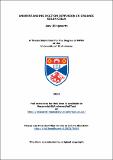Files in this item
Understanding exciton diffusion in organic solar cells
Item metadata
| dc.contributor.advisor | Samuel, Ifor D. W. | |
| dc.contributor.author | Illingworth, Amy | |
| dc.coverage.spatial | 87 | en_US |
| dc.date.accessioned | 2013-06-10T11:17:59Z | |
| dc.date.available | 2013-06-10T11:17:59Z | |
| dc.date.issued | 2012 | |
| dc.identifier.uri | https://hdl.handle.net/10023/3648 | |
| dc.description.abstract | Organic solar cells are promising candidates for future energy production. However, many challenges remain to optimise efficiency. One particular challenge lies in our understanding of the factors affecting exciton diffusion and the length scale of this process. This is particularly relevant to morphology optimisation for organic solar cells. A powerful tool to gain insight into this is femtosecond photophysical measurements. This thesis details work undertaken at the University of St Andrews between September 2009 and December 2010 towards a Masters of Philosophy. It includes an introduction to the field and a description of experimental methods used. Experimental chapters discuss measuring the optical constants of P3HT, a study of low concentration volume quenching, surface quenching measurements using titanium dioxide, surface quenching measurements using other quenchers and an investigation of the thickness dependence of the photoluminescence decay time in thin polymer films. | en_US |
| dc.language.iso | en | en_US |
| dc.publisher | University of St Andrews | |
| dc.subject.lcc | TK2960.I6 | |
| dc.subject.lcsh | Solar cells--Experiments | en_US |
| dc.subject.lcsh | Organic semiconductors--Experiments | en_US |
| dc.subject.lcsh | Polymers--Quenching--Experiments | en_US |
| dc.subject.lcsh | Exciton theory--Experiments | en_US |
| dc.title | Understanding exciton diffusion in organic solar cells | en_US |
| dc.type | Thesis | en_US |
| dc.type.qualificationlevel | Doctoral | en_US |
| dc.type.qualificationname | MPhil Master of Philosophy | en_US |
| dc.publisher.institution | The University of St Andrews | en_US |
This item appears in the following Collection(s)
Items in the St Andrews Research Repository are protected by copyright, with all rights reserved, unless otherwise indicated.

